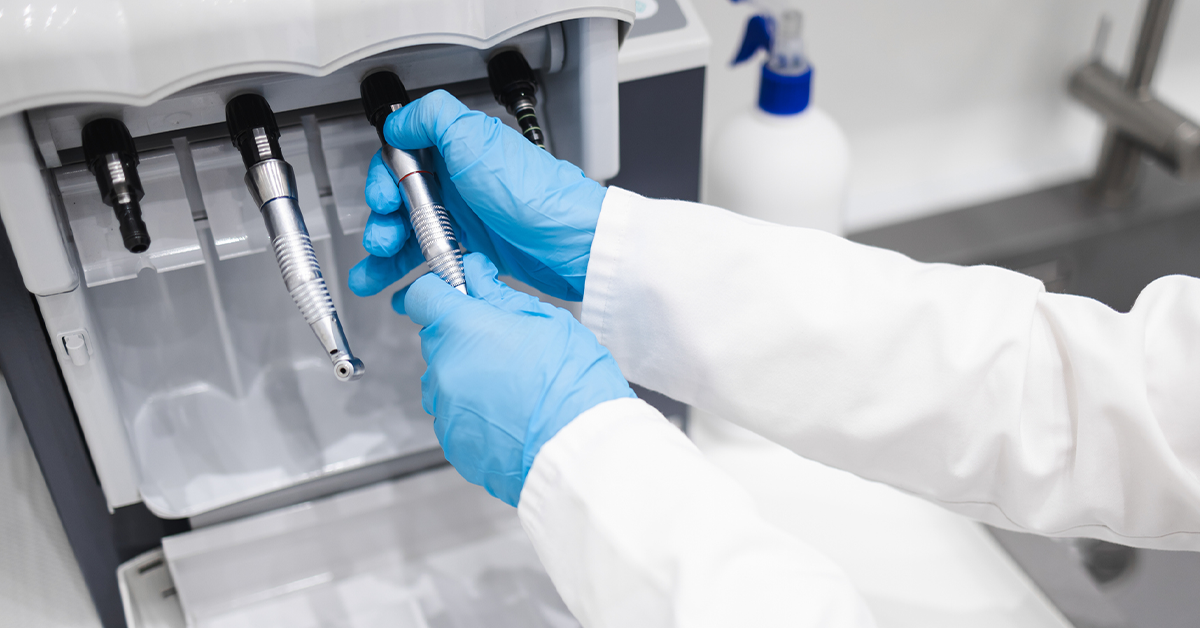Every dental professional knows that a hygiene handpiece is one of the most important tools of the oral health trade. In fact, the global handpiece market is expected to reach more than $2 billion by 2027, according to a report by Medgadget.
To ensure these indispensable instruments continue to provide safe and effective care, maintenance should be a top priority. Successful hygiene handpiece maintenance requires adhering to a strict regimen of cleaning and lubrication, which sometimes can be challenging in a busy dental practice. Fortunately, you can streamline the process to make it more efficient.
Tips for handpiece cleaning
A range of systems exists to ensure the hygiene handpiece cleaning process goes smoothly and successfully even in the most fast-paced environments. For example, handpieces must be cleaned after every use (and even between sterilizations) to avoid cross-contamination. Every single reusable tool needs to go through a step-by-step process that ensures all infection control prevention requirements are met.
Knowing how to properly clean a handpiece is the first step toward safeguarding its longevity. While you can expect that a handpiece will need to be periodically serviced depending on its cycle of use, properly maintaining these devices can help keep service calls and additional repairs to a minimum.
Maintaining a handpiece offers several other advantages, such as ensuring operational reliability when you need it most, reducing downtime and costly repairs, and ultimately staying on top of the latest infection prevention guidelines related to the newest technology.
Safe cleaning of hygiene handpieces
When it comes to the actual cleaning of a handpiece, start by wiping it down with a damp disposable cloth. This will remove any dirt, dust or biomatter before sterilizing. As with any maintenance, consult the manufacturer’s guidelines about what types of cleaners you can use. In some cases, a mild detergent works. Most times, however, running the handpiece under water and using a brush to remove any stubborn materials also works well. In addition, flushing water through a handpiece for about 30 seconds can clean out the internal water line.
Handpieces should never be fully immersed in water or any kind of disinfectant. The chemicals can create problems during the autoclaving process, which can impede proper sterilization and increase the risk for cross-contamination.
Proper handpiece lubrication techniques
Daily lubrication is a must for regularly used handpieces. The oil helps to keep the turbine, air motor, shank and head in good working order. Proper lubrication also ensures that any abrasives found in cleaners don’t get into the mechanisms of the tool itself, which can damage the turbine.
In a busy practice, there are some advantages to scheduling handpiece maintenance that considers both cleaning and oiling multiple handpieces simultaneously between appointments. Having a staff member or small team managing the overall sterilization process can help ensure that critical steps in the cleaning, lubricating and sterilizing process are taken for the best outcomes.
Lubricating a handpiece is simple if you follow a few key steps (always remembering to consult the manufacturer’s guidelines for specific models). For example, not all handpiece turbines are designed for direct lubrication. But for those handpieces that do require regular lubrication, here’s how to make the process easy and consistent:
- Disassemble the handpiece and remove the bur so you can access the internal components.
- Inject the lubricant into the air drive port so it reaches the turbine.
- Lubricate both ends of the contra-angle or remove the cylinder from the prophy angle and lubricate both ends.
- Reassemble the handpiece (don’t attach the bur) and operate it head down for between 10 and 30 seconds (depending on the manufacturer’s guidelines) to purge excess lubricant.
- Wipe any excess lubricant remaining on the handpiece with a dry gauze pad or paper towel.
Hygiene handpiece sterilization processes
Sterilization is essential in every dental practice, including hygiene handpieces. During the pandemic, this process has become especially important to ensure reduction of potential cross-contamination. New technology has aided in the process, but it still comes down to diligence and smart scheduling to avoid delays and ensure handpieces are always at the ready for treatments and cleanings.
Because handpieces are designed to be sterilized after each use, it’s important to know how to prepare them for the process without compromising the instrument itself. For example, once any debris is cleaned from the handpiece and the device is lubricated, the manufacturer’s guidelines will direct how best to sterilize the device. Frequently, recommendations include bagging and sterilizing the instrument in an autoclave or chemical vapor sterilizer. Allow the drying cycle to complete fully before removing the handpiece and schedule time for it to cool down before putting back into rotation.
Properly caring for dental handpieces not only ensures longevity and fewer service calls, it also provides the best care for patients. Ensuring that biological materials are never passed from one patient to the next should be the goal of every dental practice, particularly as the industry continues to face ongoing challenges from the COVID-19 pandemic. It not only makes sense for patient care, but it also extends the life of some of the most valuable tools in an operatory.
References and further reading
Gross RE. Handpiece maintenance 101. Dental Economics. April 10, 2015.
Medgadget. Dental handpiece market to reach USD 2.14 billion by 2027 growing at a CAGR of 5.1%. March 3, 2020.
– – –
A version of this article was originally published in the June 2022 edition of OnTarget. Read the latest edition and view current promotions at pattersondental.com/dental/ontarget.





You must be logged in to post a comment.